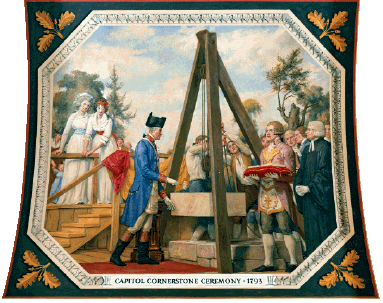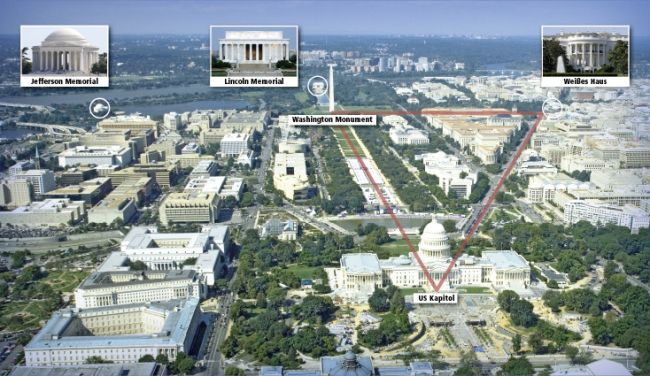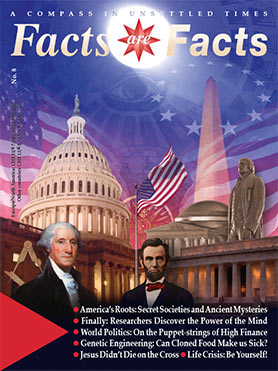America: The Dream of a better World
How a bestselling author pays homage to mankind’s spiritual potential and what that has to do with the vision of America’s Founding Fathers: on the trail of fascinating Gnostic mysteries that surround the most powerful city on earth.
Hardly any other author moves the masses as much as Dan Brown. With his Hollywood thrillers The Da Vinci Codeand Angels and Demons, he not only antagonized the Vatican, but also helped the cosmopolitan cities Rome and Paris to a whole new kind of sightseeing. Hundreds of thousands of tourists have already made their way through churches, catacombs, museums and cemeteries following the scenes of Brown’s mysterious paper chase. Although there are no ancient ruins in the New World like those in Europe, when it comes to secret societies, mystical philosophy, and symbolic architecture, Washington DC outdoes every metropolis on the earth.
So it was just a question of time until Dan Brown would use the capital of the world’s most powerful nation as the setting for one of his novels. After Brown’s publisher announced the new work, The Lost Symbol, enthusiastic speculations spread like wild fire and filled thousands of Internet sites for almost half a year. On 15 September 2009, The Lost Symbol was finally published. One million copies were sold that day and Brown’s newest pitch became the “fastest selling book of all time” (The Guardian). The millions of readers weren’t the only ones to throw themselves on the book, but also the authors of secondary literature; the books about the books published by Dan Brown. This is also a good way to make a living, apparently.
His novel Angels and Demons is a plea for the reconciliation of science and religion, which have been set against each other as incompatible opposites ever since the Enlightenment. In The Da Vinci Code, Mary Magdalene played an important role: Jesus’ earthly partner and mother of his children.1 And even though much of the speculation contained therein doesn’t hit the mark, with this book Dan Brown explained to millions of readers that, in religious matters, woman and the feminine need to be brought back into balance with man. In this way, The Da Vinci Code is also an homage to the Goddess.
The Lost Symbol once again deals with the themes of reason and religion, common sense and theology. Dan Brown makes an effort, packed in a fast-paced thriller, to reconcile modern science with the ancient mysteries. One of the characters from his novel even prophesies that the “science of belief” will soon be one of the most important branches of research. With almost messianic fervour, the best-selling author shares this one great message with his readers: namely that God dwells in man and that mankind must finally develop his divine potential and attain enlightenment.
A vision that Dan Brown shares with America’s Founding Fathers. The necessary earthly foundation was to have been laid by the United States. Thousands of years ago, mankind’s adepts had already chosen America to one day become the land of promise, a utopia of the Enlightenment and the enlightened mind of man. The fact that the USA hasn’t yet met its full potential today is certainly not the fault of the Founding Fathers; rather it is the result of an alien influence that has set Mammon in place of God.
Dan Brown begins his thriller with a quote from the American philosopher and mystic Manly P. Hall, who published the occult work The Secret Teachings of All Ages in 1928 and which is still groundbreaking in its comprehensive uniqueness. Hall’s admirers include outstanding personalities such as high-degree Freemason and American president Franklin D. Roosevelt. In his book The Secret Destiny of America Hall writes: “Thousands of years ago, in Egypt, these mystical orders were aware of the existence of the western hemisphere and the great continent which we call America. The bold resolution was made that this western continent should become the site of the philosophic empire. Just when this was done it is impossible now to say, but certainly the decision was reached prior to the time of Plato, for a thinly veiled statement of this resolution is the substance of his treatise on the Isles of Atlantis.”
So join us on a fascinating search trailing the beginnings of a unique nation, which still needs to recognise and manifest its true greatness.
The Diamond on the Potomac
Whoever has already visited America’s capital city was certainly fascinated by its bold, majestic layout and many impressive “ancient temples”. There is no other city in the world that contains more references to occult symbolism, astrology and star charts. For the city did not grow naturally over centuries or even millennia, but was rather designed on a drawing board.
In 1790 as the first president of the United States, George Washington received the mandate to create a capital for the still-young nation, a city that would express everything that the American spirit represented. No wonder then that Athens, and especially Rome, stood as architectural ‘godfathers’, as they embody the golden age of the human spirit, as the antiquities were seen to be at the time of the Enlightenment.2 So, for example, the US Capitol stands on Capitol Hill, a nod of the head to the Capitoline Hill, one of Rome’s seven hills. Another nod to the Eternal City is Tiber Creek, a small river that flows through the US capital. And also George Washington’s epithet—“Father of the Nation” Pater Patriae—is a designation that we know from the ancient Roman emperors.
“The city of Washington DC lies on the banks of the Potomac River like a sparkling diamond in the middle of the gentle hills of Virginia and Maryland,” writes Simon Cox in his book, Decoding The Lost Symbol. “In point of fact, the original 260 square kilometre District of Columbia(abbreviated DC) was once laid out in the form of a diamond whose corners pointed in the four cardinal directions.” But because the city didn’t grow as quickly as was expected, they gave the land to the west of the Potomac back to Virginia, resulting in the shape and size the area has today.
The diamond, symbol of the immaculate purity of the mind, announced to the world that the capital city of the USA was not only to be a shining jewel, but also America’s diamond heart, and not just in a figurative sense. Thomas Jefferson, the third US president, wanted to introduce a geographical prime meridian for the western hemisphere that would have passed through the middle of Washington DC. The site in question, located on the former bank of the Potomac and only a stone’s throw from today’s Washington Monument, was for a long time marked by a carved stone called Jefferson Pier.
With George Washington’s and Thomas Jefferson’s help, the French architect Pierre L’Enfant completed the first drafts for the city plans. Today, the American capital city is arranged around a gigantic Christian cross made from five of the most impressive structures: the foot of the cross is marked through the US Capitol (east) and the top through the Lincoln Memorial (west), while the cross beam runs through the White House (north) and ends at the Thomas Jefferson memorial (south). Not coincidentally, the Washington Monument, the largest obelisk in the world, stands at the heart-centre of the cross. (ref: city map on pg. 43)

18 September 1793: on this astrologically important day, President George Washington laid the cornerstone to the US Capitol in full Masonic regalia.
But when Pierre L’Enfant presented the first plans in 1791, the two main optical axes did not form a cross, since the present locations of the Jefferson and Lincoln Memorials were to remain beneath the Potomac, whose waters lapped the shore directly west of the present Washington Monument, for another hundred years. So in the centre of the city, instead of a cross, a great “L” or triangle was built—which indicates how deeply indebted to the philosophical and mystical ideas of antiquity America’s Founding Fathers felt themselves to be. For Pythagoras’ right-angled triangle symbolically represents probably the most important thinker of ancient Greece.
A Heavenly Triangle
In that sense, we also talk about the Federal Triangle. The long side (in geometric terms, the hypotenuse) runs along Pennsylvania Avenue, which leads from the White House to the Capitol. The respective connecting lines from these two buildings to the architectural heart of the city, the Washington Monument, create the other perpendicular sides of the triangle (the two “catheti”).
Now, the astute observer of the city plans will notice that the Washington Monument seems to be slightly displaced to the right. The monument does not stand today on the place where it was actually supposed to be erected, but rather 119 metres to the east: the ground at the original spot was too boggy to bear the weight of the stone column. Today a small granite block marks this same spot that Thomas Jefferson originally intended to be the second prime meridian of the United States.
From all the great minds of antiquity, this geometrical reference to the “Sage of Samos” was chosen with good reason. The philosopher Pythagoras lived 600 years before Christ and is known as the founder of mathematics and natural science. He was also one of the most important initiates in the history of mankind and called into life the influential religious-philosophical school of the Pythagoreans, whose ideas ran through and were upheld by many mystical secret societies over hundreds of years, including the Freemasons, when they were still unconditionally committed to the Light. The Freemasons played an important role in founding the United States as well as in planning the city of Washington DC. George Washington himself was the “Worshipful Master in the Chair” (president) of a Freemason lodge in the town of Alexandria, which lies near the capital, at the time of his inauguration as US President. In Alexandria also stands the George Washington National Masonic Memorial, a museum modelled on the Great Pharos lighthouse,3 which the Freemasons built in honour of the first US president.
Masonic rituals assumed a central role in the formation of the American capital city. On 18 September 1793, George Washington led a parade to the planned location of the US capitol and laid the cornerstone. The President wore a Freemason apron to the festivities and gave traditional Masonic offerings of grain, wine, and oil. He then spread the mortar with a silver trowel that had been made especially for the occasion. Visitors can admire the ceremony in a fresco in the capitol. The cornerstones for almost all of the most important buildings in Washington were also laid in Masonic ceremonies. That includes of course the White House and the Washington Monument, both of which form the other corners of the Federal Triangle. Yet another peculiarity connects these three buildings: even though the cornerstone ceremonies were held in different years, the astrological constellation was always the same—the ascending lunar node (Caput Draconis) was in Virgo. People with this lunar node in their birth chart are to learn diligence, patience, and the ability to optimally organise themselves. For a nation, this means that it is to bring forth order from chaos—Ordo ab Chao—a motto that we will soon encounter again.
In his book The Secret Architecture of Our Nation’s Capital, the author David Ovason maintains that Washington contains around twenty complete zodiacs, although the sign of Virgo is certainly the most important. So, according to Ovason, the Federal Triangle is meant to be an earthly representation of the celestial triangle made up by the main stars in the constellation Virgo: Arcturus falls on the White House, Regulus is the Capitol and Spica corresponds to the Washington Monument.
“Who today possesses a power of imagination such as Pierre L’Enfant had in the Spring of 1791 as he visualized Washington DC in relation to a heavenly axis and thereby began to imprint a geometrical pattern on the American landscape that perfectly mirrored the revolutionary principles of the young nation?” asks Nicholas Mann in The Sacred Geometry in Washington DC. “The city that L’Enfant envisioned, designed, and in which he passionately believed, was to exceed anything that people of that time could possibly imagine.”
Sources
- 1 see our article Jesus Didn't Die on the Cross
- 2 You can read more about “America’s secret destiny” as well as the background of its discovery and the founding of the USA here: America: The Promised Land & America: The Land of Brotherhood.
- 3 The lighthouse that towered on the Mediterranean shoreline outside the city of Alexandria (Egypt) was one of the Seven Wonders of the Ancient World.







